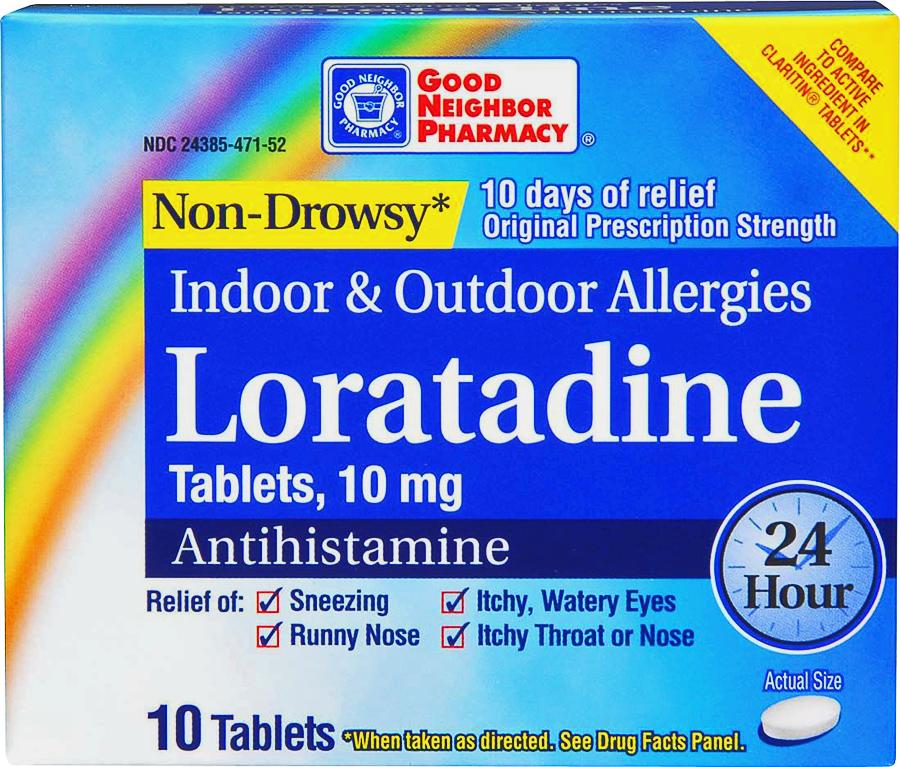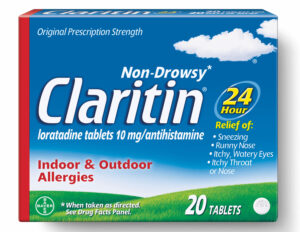
Loratadine – Uses, Side Effects, Interactions & More
What is Loratadine?
Loratadine is an over-the-counter antihistamine used to treat symptoms of seasonal allergies, hay fever, and hives. It is available in various forms, including tablets, liquid syrup, and dissolving tablets. is a second-generation antihistamine commonly used to manage and treat allergies. It produces its effect by inhibiting histamine release, a chemical in the body that potentiates allergic symptoms. Below is a detailed look at the uses, side effects, interactions, and other important information regarding loratadine.
Uses of Loratadine
It is commonly prescribed for:
- Allergic Rhinitis (Hay Fever)
- Symptoms Treated: Sneezing, runny nose, itchy/watery eyes, and nasal congestion.
- Chronic Urticaria (Hives)
- Symptoms Treated: Red, itchy lesions or bumps due to an allergic reaction on the skin.
- Seasonal Allergies
- Treats: Pollen, dust, and mold allergies, providing relief from common allergic reactions during certain seasons.
How Loratadine Works
Loratadine blocks H1 receptors in the body. Histamine is released during allergic reactions, causing itching, swelling, and redness. By preventing histamine from binding to these receptors, it reduces these symptoms.
Side Effects of Loratadine
Although generally well-tolerated, it may cause some side effects:
-
Common Side Effects
- Dry mouth
- Headache
- Fatigue
- Dizziness
-
Less Common but Serious Side Effects
- Rapid heartbeat
- Swelling of the face, tongue, or lips (but these are rare allergic reactions)
- Difficulty breathing (a major sign of allergic reaction)
Most side effects are mild, but any severe reaction should prompt immediate medical attention.
Popular Brands of Loratadine
Several brands market loratadine under different names. Some well-known ones include:
- Claritin
- Alavert
- Equate (Generic)
- Kirkland Signature (Generic)
These brands provide it in multiple forms like tablets, syrup, and dissolvable strips.
Claritin
Generic Name loratadine
Imprint CLARITIN 10 458
Strength 10 mg
Color White
Shape Round
Availability Rx and/or OTC
Drug Class Antihistamines
Pregnancy Category B
Drug Interactions with Loratadine
Loratadine may interact with other medications, likely altering its effects:
- Antifungal Medications
- Example: Ketoconazole or itraconazole
- Effect: Can increase loratadine levels in the body, leading to an increased risk of side effects.
- Antibiotics
- Example: Erythromycin
- Effect: It may increase loratadine’s concentration in the bloodstream.
- Other Antihistamines
- Effect: Taking Claritin with other antihistamines can enhance sedative effects or drowsiness.
- Alcohol
- Effect: Combining loratadine with alcohol can enhance drowsiness or dizziness.
Always consult a doctor before combining it with other medications to avoid harmful interactions.
Contraindications: Who Should Avoid Loratadine?
It is generally safe for most people, but certain individuals should avoid or use it cautiously:
- Pregnancy
- It is considered relatively safe during pregnancy, but it should only be used when needed and under the guidance of a healthcare provider.
- Breastfeeding
- It passes into breast milk in small amounts. It is advisable to consult a doctor if breastfeeding.
- Liver or kidney disease
- People with intense liver or kidney impairment may require dosage adjustments.
- Allergic Reactions
- Individuals who have had allergic reactions to loratadine in the past should avoid using it.
How to Take Claritin?
Claritin is typically taken once a day. The dosage may vary depending on age, health condition, and form it used:
- For Adults: 10 mg once a day.
- For Children (2-5 years): 5 mg of drug once a day in liquid form.
- For Children (6 years and above): 10 mg daily (tablet or syrup form).
It can be taken with or without food. Always consider the instructions or advice on the packaging or by your health care provider.
Conclusion
What is loratadine? It is an effective, non-drowsy antihistamine for relieving allergy symptoms. Understanding its uses, potential side effects, interactions, and contraindications ensures safe and effective treatment. Always consult with a healthcare provider before starting new medication, especially if you have underlying conditions or are taking other medications.\4r\14444444444444444444444444444gggcg
